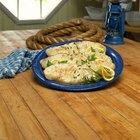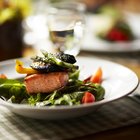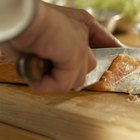DukeII/iStock/GettyImages
You could consider hake an "everyfish." You know, the type of mild, white-fleshed variety you can do just about anything with – grilling, frying, roasting, steaming; you name it. A bit more mild than cod and quite flaky, hake pairs well with just about any side dish and gives you a lot of latitude for creativity and style.
Tomatoes, capers, onions and herbs, for example, make unctuous complementary ingredients to cook with hake fillets. If you want to go "dry," you can do that too. A little extra olive oil and you can re-create the taste and texture of pan-fried hake while you utilize the remaining oven space for matching sides like garlic roasted broccoli, oven-baked asparagus "fries," and crispy salt and vinegar "chips" made with fingerling potatoes. Start with the basic hake-bake technique:
Prepare: Hake fillets don't require any prep work themselves, other than patting them dry and seasoning them to taste with kosher salt and freshly ground black pepper (or your spices of choice). Also, if you buy a whole hake fillet (they weigh about 1 pound), you might want to cut it into halves or fourths to make serving easier.
If you plan to bake the hake with complementary ingredients, such as onions and capers, cut, slice and dice the ingredients as needed. Heat the oven to 375F, and brush the hake with olive oil or melted butter.
Place a few sliced onion or lemons (at least 1/4-inch thick) in the bottom of the baking dish; this elevates the fillets and contributes to better browning. After you arrange the fillets on the sliced onions or lemons, add the secondary ingredients around them. Crushed tomatoes, thinly sliced onions or shallots, minced garlic and basil make a classic combination to get you started.
Set the dish on the center rack and let the oven do its thing. A 3/4- to 1-inch-thick hake fillet takes about 15 to 20 minutes to roast, uncovered. When ready, the temperature of center of the fillet will be 145F, and its flesh will flake easily.
Squeeze a little fresh lemon juice over the fillets and spoon some of the side ingredients over the top. Garnish with freshly chopped parsley, if desired.
Related Articles
How to Cook a Turbot in the Oven

How to Cook Rockfish Fillets

How to Cook Amberjack on the Grill

How to Cook Tilapia Filets in the Oven

How to Prepare Fabulous Baked Halibut

How to Cook Walleye by Broiling

How to Cook Jamaican Jerk Salmon

How to Broil Salmon in Foil

How to Cook Whiting in the Oven
How to Cook a Bass Fillet

How to Cook Grey Sole Easily

How to Cook Flounder Fillets

How to Bake Lingcod

How to Cook Silver Salmon

How to Cook a Pork Loin Fillet
How to Cook Seasoned Keta Salmon

How to Cook a Grey Filet of Sole

How to Pan Fry Grouper

How to Pan Fry Tasty Perch Fillets

How to Cook Axis Deer Steaks
References
Tips
- A general rule for cooking fish is to measure the flesh at its thickest point, and cook 8 to 10 minutes per inch, 4 to 5 minutes per half-inch.
- When purchasing fresh fish fillets, make sure they have a fresh odor, firm texture and a moist appearance.
- When purchasing frozen fish fillets, make sure they are solidly frozen and don't have an odor. Do not purchase frozen fish fillets if there are any white, dark, icy or dry spots present.
- Substitute cod, grouper or haddock if you can't find hake fillets.
Warnings
- Fish should be cooked to an internal temperature of 145 F. Consumption of undercooked fish could lead to a foodborne illness.
Writer Bio
A.J. Andrews' work has appeared in Food and Wine, Fricote and "BBC Good Food." He lives in Europe where he bakes with wild yeast, milks goats for cheese and prepares for the Court of Master Sommeliers level II exam. Andrews received formal training at Le Cordon Bleu.